Pumping Station Desing - Second Edition by Robert L. Sanks, George Tchobahoglous, Garr M. Jones
Подождите немного. Документ загружается.

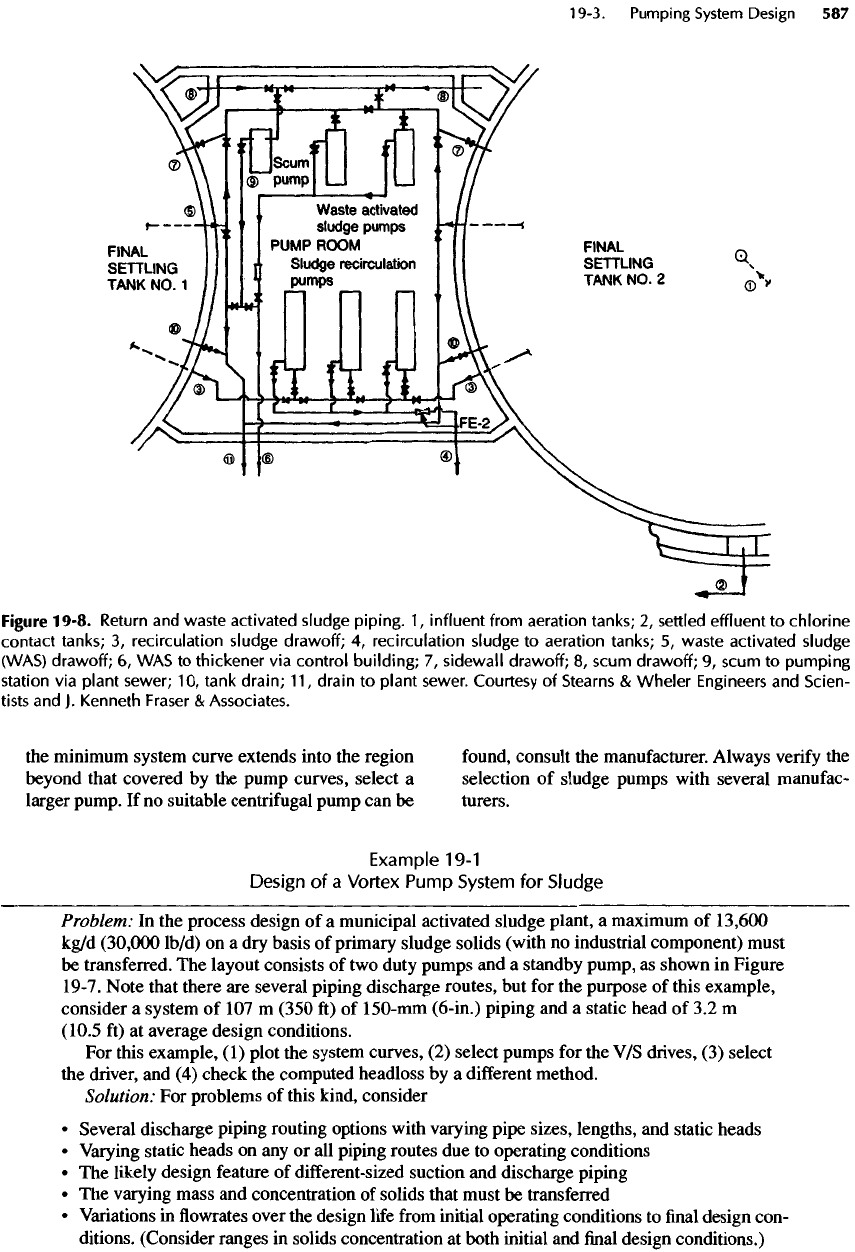
the
minimum system curve extends into
the
region
beyond that covered
by the
pump curves, select
a
larger pump.
If no
suitable centrifugal pump
can be
found,
consult
the
manufacturer. Always
verify
the
selection
of
sludge pumps with several
manufac-
turers.
Figure
19-8.
Return
and
waste
activated
sludge
piping.
1,
influent
from
aeration
tanks;
2,
settled
effluent
to
chlorine
contact
tanks;
3,
recirculation
sludge
drawoff;
4,
recirculation
sludge
to
aeration
tanks;
5,
waste
activated
sludge
(WAS)
drawoff;
6, WAS to
thickener
via
control
building;
7,
sidewall
drawoff;
8,
scum
drawoff;
9,
scum
to
pumping
station
via
plant
sewer;
10,
tank
drain;
11,
drain
to
plant
sewer.
Courtesy
of
Stearns
&
Wheler
Engineers
and
Scien-
tists
and J.
Kenneth
Fraser
&
Associates.
Example
19-1
Design
of a
Vortex
Pump
System
for
Sludge
Problem:
In the
process design
of a
municipal activated sludge plant,
a
maximum
of
13,600
kg/d
(30,000
Ib/d)
on a dry
basis
of
primary sludge solids (with
no
industrial component) must
be
transferred.
The
layout consists
of two
duty pumps
and a
standby pump,
as
shown
in
Figure
19-7. Note that there
are
several piping
discharge
routes,
but for the
purpose
of
this example,
consider
a
system
of 107 m
(350
ft) of
150-mm
(6-in.) piping
and a
static head
of 3.2 m
(10.5
ft) at
average design conditions.
For
this example,
(1)
plot
the
system curves,
(2)
select pumps
for the V/S
drives,
(3)
select
the
driver,
and (4)
check
the
computed headloss
by a
different
method.
Solution:
For
problems
of
this kind, consider
•
Several discharge piping routing options with varying pipe sizes, lengths,
and
static heads
•
Varying static heads
on any or all
piping routes
due to
operating conditions
• The
likely design
feature
of
different-sized
suction
and
discharge piping
• The
varying mass
and
concentration
of
solids that must
be
transferred
•
Variations
in flowrates
over
the
design
life
from
initial operating conditions
to final
design con-
ditions. (Consider ranges
in
solids concentration
at
both initial
and final
design conditions.)
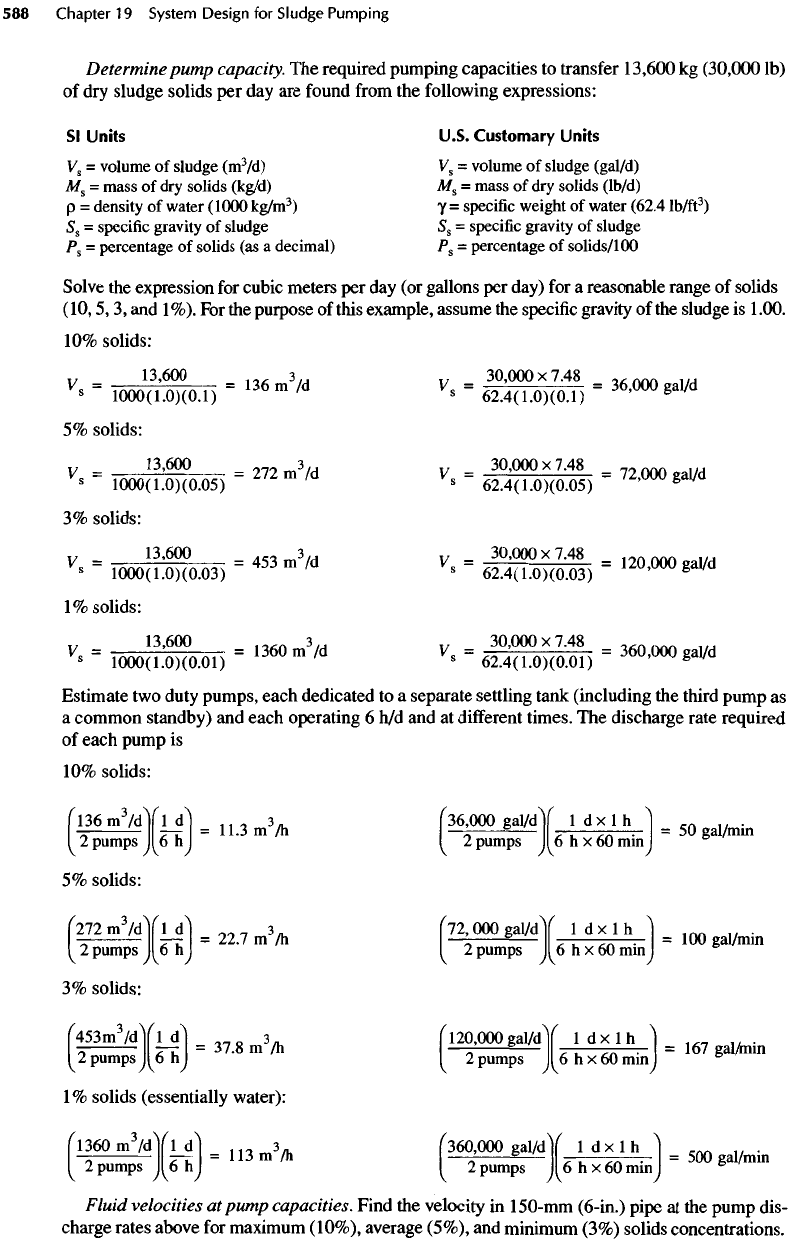
Determine
pump
capacity.
The
required pumping capacities
to
transfer
13,600
kg
(30,000
Ib)
of
dry
sludge solids
per day are
found
from
the
following expressions:
Sl
Units
U.S.
Customary
Units
V
s
=
volume
of
sludge
(m
3
/d)
V
s
=
volume
of
sludge
(gal/d)
Af
8
=
mass
of dry
solids
(kg/d)
M
8
=
mass
of dry
solids
(Ib/d)
p
=
density
of
water
(1000
kg/m
3
)
y
=
specific
weight
of
water
(62.4
lb/ft
3
)
S
8
=
specific
gravity
of
sludge
S
8
=
specific
gravity
of
sludge
P
s
=
percentage
of
solids
(as a
decimal)
P
5
=
percentage
of
solids/100
Solve
the
expression
for
cubic meters
per day (or
gallons
per
day)
for a
reasonable range
of
solids
(10,5,3,
and
1%).
For the
purpose
of
this example, assume
the
specific gravity
of the
sludge
is
1.00.
10%
solids:
T/
13,600
.„
3
/H
30,000
x
7.48
^nm^i/H
V
*
=
1000(LO)(O.!)
=
B6m
/d
V
*
=
62.4(1.0)(0.1)
=
3
^
000
^
al/d
5%
solids:
T/
13
»
600
OTO
3
M
\/
30,000
x
7.48
70
^
.
V
*
=
1000(1.0)(0.0l)
=
2?2m
/d
V
*
=
(S2.4(1.0)(0.05)
=
7
^
000
*
al/d
3%
solids:
13,600
„,-,,
3,,
T7
30,000X7.48
,/,nnnA
i
/
J
K
°
=
1000(i:0)(0.03)
=
453m
/d
V
'
=
62.4(1.0)(0.03)
=
12
O'
000
^
1%
solids:
T/
13,600
™
3,,
T/
30,000x7.48
™
mn
.
V
-
=
1000(1.0X0.01)
=
136
°
m
/d
Vs
=
62.4(1.0)(0.01)
=
3
^'
000
gaW
Estimate
two
duty pumps, each dedicated
to a
separate settling tank (including
the
third pump
as
a
common standby)
and
each operating
6
h/d
and at
different
times.
The
discharge rate required
of
each pump
is
10%
solids:
(l36m
3
/d](l
d]
tl
*
3«
^36,000
gaVdY
Idxlh
")
_
n
..
.
-^-
—
-r-r
=
11.3
m
/h
—^
^-^
—r—T^—r-
= 50
gal/min
I
2
pumps
Jl 6
hi
I 2
pumps
Il
6 h x 60
mini
6
5%
solids:
f272
m
3
/d¥l
d\
^
n
3.
f
72,000
gaVdY
Idxlh
^
inn
...
T—~~^
TT
=
22
-
7
m
/h
—k
^^
7-^—TT^——
= 100
gal/mm
I
2
pumps
Il
6
hi
12
pumps
Jl 6 h x 60
mmj
6
3%
solids:
f453m
3
/dYl
d]
a
_
0
3.
f
120,000gal/dY
Idxlh
^l
t
,_
..
.
—
7-r-
=
37.8
m
/h
—-2
2-^-
--———r-
= 167
gal/mm
I
2
pumps
Jl 6
hj
12
pumps
Jl 6 h x 60
mmJ
&
1%
solids (essentially water):
("136Om
3
AlYIdI
11<a
3.
^360,000
gal/dY
Idxlh
1
CAn
..
.
"^
z-e
=
113
m
/h
—^
^
-1
-
FT—^T;—-
=
500
gal/mm
I
2
pumps
Jl 6
hj
12
pumps
Jl 6 h x 60
mmj
6
Fluid
velocities
at
pump capacities. Find
the
velocity
in
150-mm
(6-in.)
pipe
at the
pump
dis-
charge rates above
for
maximum (10%), average (5%),
and
minimum (3%) solids concentrations.
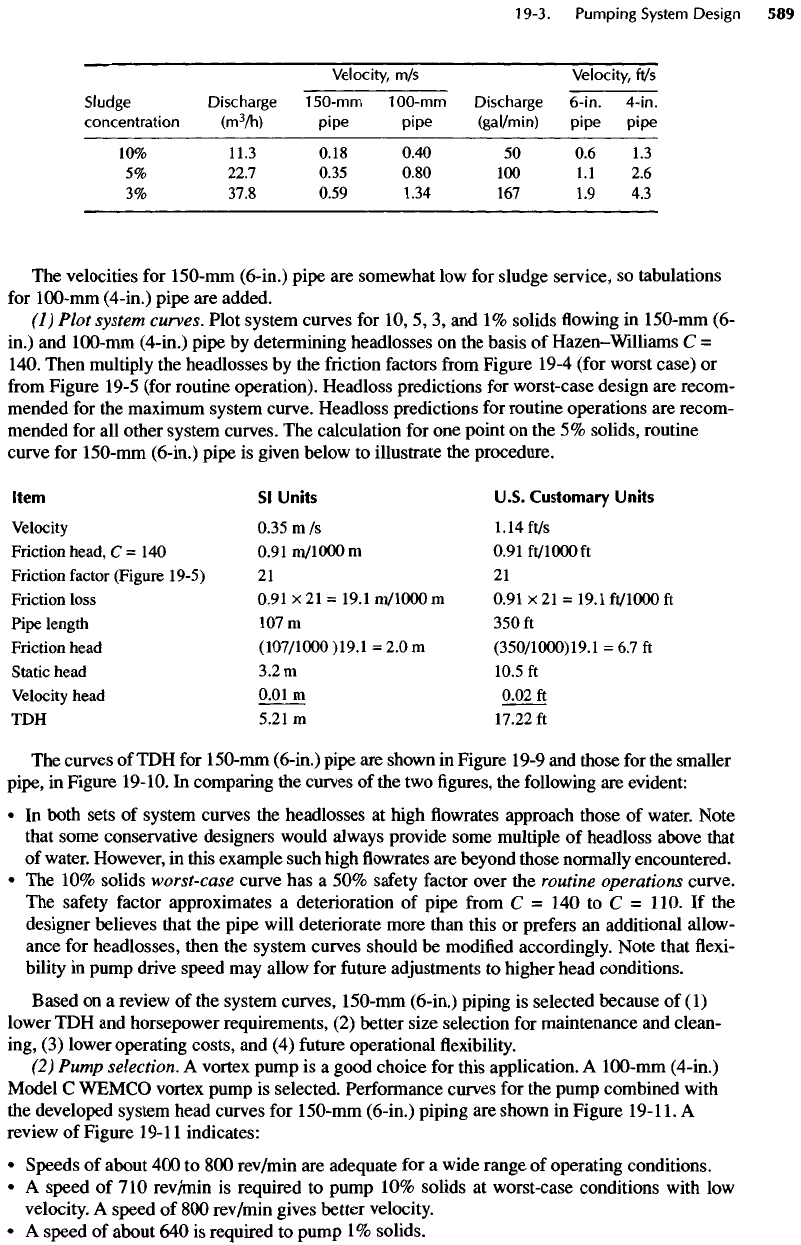
Velocity,
m/s
Velocity,
ft/s
Sludge
Discharge
150-mm
100-mm
Discharge
6-in.
4-in.
concentration
(m
3
/h)
pipe pipe
(gal/min)
pipe pipe
10%
11.3 0.18 0.40
50 0.6 1.3
5%
22.7 0.35 0.80
100 1.1 2.6
3%
37.8 0.59 1.34
167 1.9 4.3
The
velocities
for
150-mm (6-in.) pipe
are
somewhat
low for
sludge service,
so
tabulations
for
100-mm (4-in.) pipe
are
added.
(1)
Plot
system
curves.
Plot system curves
for 10, 5, 3, and
1%
solids
flowing in
150-mm
(6-
in.)
and
100-mm (4-in.) pipe
by
determining
headlosses
on the
basis
of
Hazen-Williams
C =
140. Then multiply
the
headlosses
by the
friction factors
from
Figure
19-4
(for worst case)
or
from
Figure
19-5
(for routine operation). Headloss predictions
for
worst-case design
are
recom-
mended
for the
maximum system curve. Headloss predictions
for
routine operations
are
recom-
mended
for all
other system curves.
The
calculation
for one
point
on the 5%
solids, routine
curve
for
150-mm (6-in.) pipe
is
given below
to
illustrate
the
procedure.
Item
Sl
Units U.S. Customary Units
Velocity
0.35
m/s
1.14
ft/s
Friction
head,
C = 140
0.91
m/1000
m
0.91
ft/1000
ft
Friction
factor
(Figure
19-5)
21 21
Friction
loss 0.91
x 21
=
19.1
m/1000
m
0.91
x 21 =
19.1
ft/1000
ft
Pipe
length
107 m 350 ft
Friction
head
(107/1000 )19.1
= 2.0 m
(350/1000)19.1
= 6.7 ft
Static
head
3.2 m
10.5
ft
Velocity
head
0.01
m
0.02
ft
TDH
5.21m
17.22ft
The
curves
of TDH for
150-mm
(6-in.) pipe
are
shown
in
Figure
19-9
and
those
for the
smaller
pipe,
in
Figure
19-10.
In
comparing
the
curves
of the two
figures,
the
following
are
evident:
• In
both sets
of
system curves
the
headlosses
at
high
flowrates
approach those
of
water. Note
that
some conservative designers would always provide some multiple
of
headloss above that
of
water. However,
in
this example such high
flowrates are
beyond those normally encountered.
• The 10%
solids
worst-case
curve
has a 50%
safety
factor over
the
routine
operations
curve.
The
safety
factor approximates
a
deterioration
of
pipe
from
C=
140 to C =
110.
If the
designer believes that
the
pipe will deteriorate more than this
or
prefers
an
additional allow-
ance
for
headlosses, then
the
system curves should
be
modified accordingly. Note that
flexi-
bility
in
pump drive speed
may
allow
for
future
adjustments
to
higher head conditions.
Based
on a
review
of the
system curves, 150-mm (6-in.) piping
is
selected because
of (1)
lower
TDH and
horsepower requirements,
(2)
better size selection
for
maintenance
and
clean-
ing,
(3)
lower operating costs,
and (4)
future
operational
flexibility.
(2)
Pump
selection.
A
vortex pump
is a
good choice
for
this application.
A
100-mm (4-in.)
Model
C
WEMCO vortex pump
is
selected. Performance curves
for the
pump combined with
the
developed system head curves
for
150-mm
(6-in.) piping
are
shown
in
Figure
19-11.
A
review
of
Figure
19-11
indicates:
•
Speeds
of
about
400 to 800
rev/min
are
adequate
for a
wide range
of
operating conditions.
• A
speed
of 710
rev/min
is
required
to
pump
10%
solids
at
worst-case conditions with
low
velocity.
A
speed
of 800
rev/min gives better velocity.
• A
speed
of
about
640 is
required
to
pump
1%
solids.

Figure
19-9.
System
H-Q
curves
for
sludge
in a
150-mm
(6-in.)
pipe.
Figure
19-10.
System
H-Q
curves
for
sludge
in a
100-mm
(4-in.)
pipe.

Solids
(%)
Speed
(rev/min)
Flow
(m
3
/h)
TDH (m)
Flow
(gal/min)
TDH
(ft)
10*
710
11.3 8.81
50
28.9
10
b
600
11.3 6.13
50
20.1
5
b
570
22.7 5.67
100
18.6
3
b
525
37.9 4.27
167
14.0
l
b
640
113.3 5.27
500
17.3
a
Worst-case.
b
Routine
operation.
(3)
Select
the
driver.
Following
the
pump
selection,
a
decision
can now be
made
to
limit
the
drive
speed
to
desirable values.
The
motor horsepower
is
determined
by the
intersection
of the
water
system curve with
the
maximum drive output speed.
In
this example,
if the
maximum
drive
output speed
is
chosen
to be 900
rev/min,
the
motor horsepower must
be 20.
Select
the
best practical motor drive
and
pump speed combination based
on
costs, sizes,
and
equipment
Figure
19-11.
Performance
curves
for a
100-mm
(4-in.)
vortex
pump
and
system
curves
for a
150-mm
(6-in.)
pipe.
After
WEMCO.
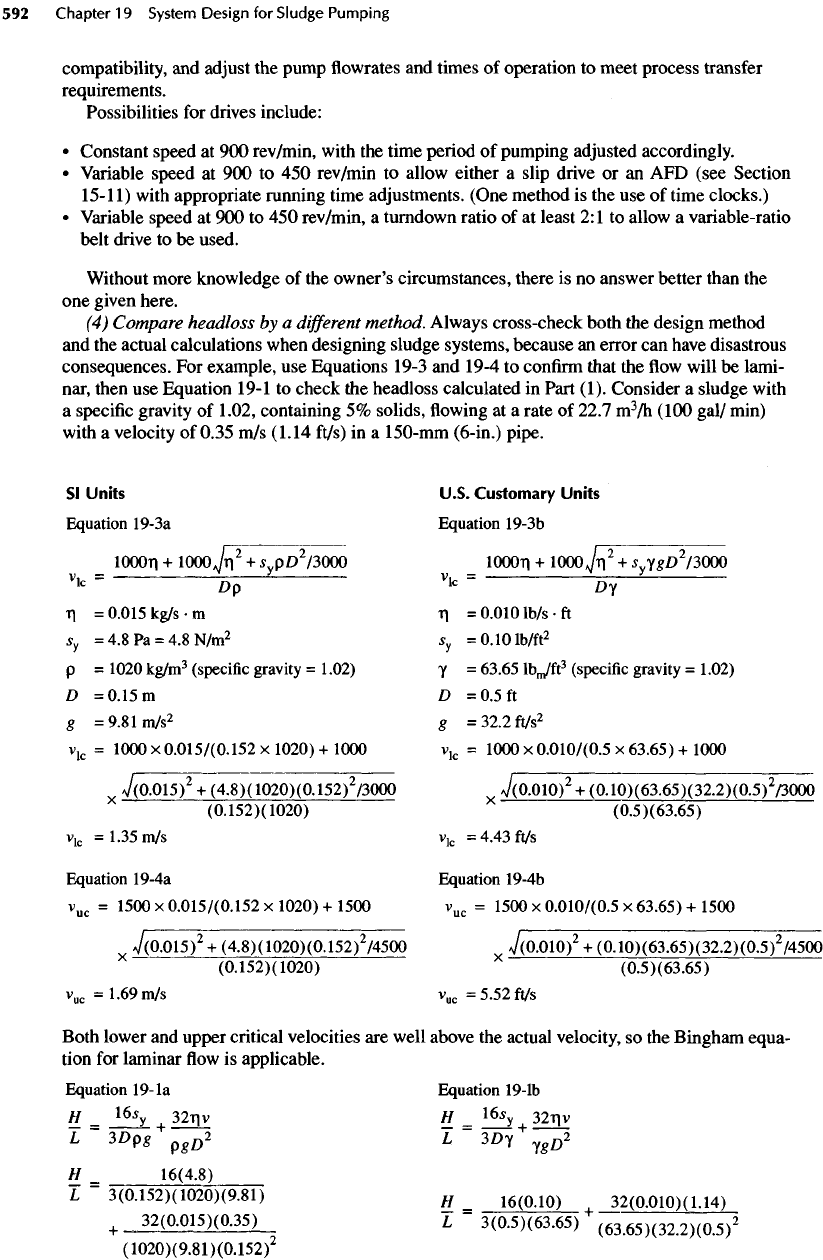
compatibility,
and
adjust
the
pump
flowrates and
times
of
operation
to
meet
process
transfer
requirements.
Possibilities
for
drives include:
•
Constant speed
at 900
rev/min,
with
the
time period
of
pumping adjusted accordingly.
•
Variable speed
at 900 to 450
rev/min
to
allow either
a
slip drive
or an AFD
(see
Section
15-11)
with appropriate running time adjustments. (One method
is the use of
time clocks.)
•
Variable speed
at 900 to 450
rev/min,
a
turndown ratio
of at
least
2:1
to
allow
a
variable-ratio
belt drive
to be
used.
Without
more knowledge
of the
owner's circumstances, there
is no
answer better than
the
one
given here.
(4)
Compare
headloss
by a
different
method. Always cross-check both
the
design method
and
the
actual calculations when designing sludge systems, because
an
error
can
have disastrous
consequences. For example, use Equations 19-3 and 19-4 to
confirm
that the flow will be lami-
nar,
then
use
Equation
19-1
to
check
the
headloss calculated
in
Part
(1).
Consider
a
sludge with
a
specific gravity
of
1.02, containing
5%
solids,
flowing at a
rate
of
22.7
m
3
/h
(100 gal/ min)
with
a
velocity
of
0.35
m/s
(1.14 ft/s)
in a
150-mm
(6-in.) pipe.
Sl
Units
U.S.
Customary
Units
Equation
19-3a Equation
19-35
lOOOri
+
1000
Jn^+ZpD
2
/3000
1000r|
+
1000
Jn
2
+
xysZ^/3000
v,
=
——
-—
*
v,
=
——
=
lc
Dp
lc
Dy
Tl
=
0.015
kg/s-m
TI
=
0.010
Ib/s
- ft
s
y
= 4.8 Pa = 4.8
N/m
2
s
y
=0.101b/ft
2
p
=1020
kg/m
3
(specific gravity
=
1.02)
y
=
63.65
Ibjft
3
(specific gravity
=
1.02)
D
=
0.15m
D
=0.5
ft
g
=9.81
m/s
2
g
=32.2
ft/s
2
v
lc
=
1000
x
0.0157(0.152
x
1020)
+
1000
v
lc
=
1000
x
0.0107(0.5
x
63.65)
+
1000
V(a015)^r(4.8)(1020)(0.152)
2
/3000
V(OOlO)
2
+
(0.10)(63.65)(3^2)(a5)^QQO
X
(0.152)(1020)
X
(0.5)(63.65)
v
lc
=1.35
m/s
v
k
=4.43
ft/s
Equation
19-4a Equation 19-4b
v
uc
=
1500
x
0.0157(0.152
x
1020)
+
1500
v
uc
=
1500
x
0.010/(0.5
x
63.65)
+
1500
7(0015)^^1^^
^/(aO^Q)
2
+
(0.10)
(63.65)
(32.2)
(05)^74500
(0.152)(1020)
(0.5)(63.65)
v
uc
=1.69
m/s
v
uc
=5.52
ft/s
Both
lower
and
upper critical velocities
are
well above
the
actual velocity,
so the
Bingham
equa-
tion
for
laminar
flow is
applicable.
Equation
19-Ia
Equation
19-lb
H
=
16
j
y
32T
1
V
H
=
^y
32Ti
v
L
3D
P*
pgD
2
L
™y
JgD
2
H
=
16(4.8)
L
3(0.152)(1020)(9.81)
H
=
16((UO)
32(0.010)(1.14)
+
32(0.015X0.35)
L
3(0.5)(63.65)
(6
3.
6
5
)(32
.2
K
0.5)
2
(1020)(9.81)(0.152)
2
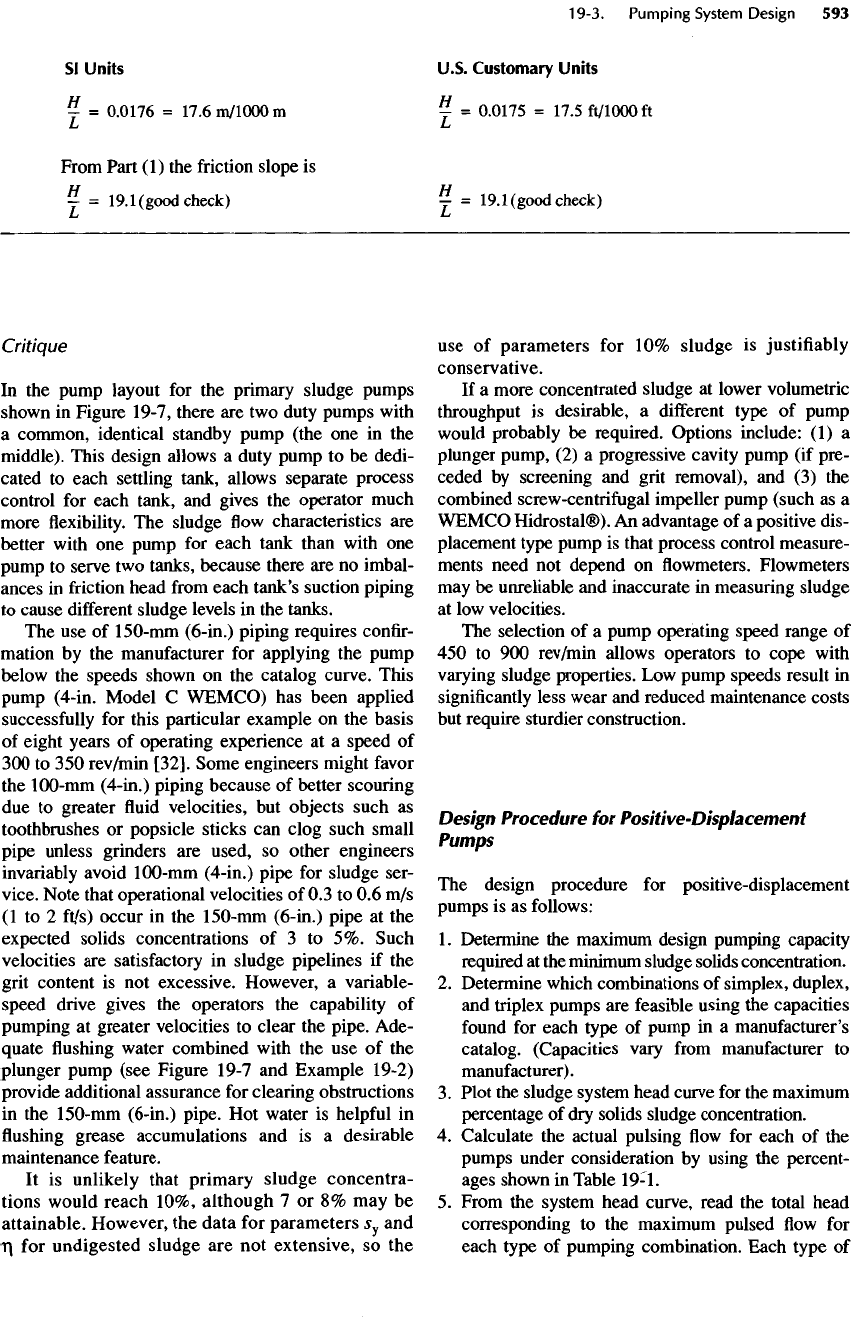
Sl
Units
- =
0.0176
=
17.6
m/1000
m
Li
From Part
(1)
the
friction
slope
is
j-
=
19.1
(good
check)
LJ
Critique
In the
pump layout
for the
primary sludge pumps
shown
in
Figure
19-7,
there
are two
duty pumps with
a
common, identical standby pump (the
one in the
middle). This design allows
a
duty
pump
to be
dedi-
cated
to
each settling tank, allows separate process
control
for
each tank,
and
gives
the
operator much
more
flexibility. The
sludge
flow
characteristics
are
better with
one
pump
for
each tank than with
one
pump
to
serve
two
tanks, because there
are no
imbal-
ances
in
friction
head
from
each tank's suction piping
to
cause
different
sludge levels
in the
tanks.
The use of
150-mm
(6-in.) piping requires
confir-
mation
by the
manufacturer
for
applying
the
pump
below
the
speeds shown
on the
catalog curve. This
pump
(4-in. Model
C
WEMCO)
has
been applied
successfully
for
this particular example
on the
basis
of
eight years
of
operating experience
at a
speed
of
300 to 350
rev/min
[32].
Some engineers might
favor
the
100-mm
(4-in.) piping because
of
better scouring
due
to
greater
fluid
velocities,
but
objects such
as
toothbrushes
or
popsicle sticks
can
clog such small
pipe unless grinders
are
used,
so
other engineers
invariably
avoid 100-mm (4-in.) pipe
for
sludge ser-
vice. Note that operational velocities
of 0.3 to 0.6 m/s
(1
to 2
ft/s) occur
in the
150-mm (6-in.) pipe
at the
expected solids concentrations
of 3 to 5%.
Such
velocities
are
satisfactory
in
sludge
pipelines
if the
grit
content
is not
excessive. However,
a
variable-
speed drive gives
the
operators
the
capability
of
pumping
at
greater velocities
to
clear
the
pipe.
Ade-
quate
flushing
water combined with
the use of the
plunger
pump (see Figure 19-7
and
Example 19-2)
provide additional assurance
for
clearing obstructions
in
the
150-mm (6-in.) pipe.
Hot
water
is
helpful
in
flushing
grease accumulations
and is a
desirable
maintenance
feature.
It is
unlikely that primary sludge concentra-
tions would reach 10%, although
7 or 8% may be
attainable. However,
the
data
for
parameters
s
y
and
Tj
for
undigested sludge
are not
extensive,
so the
U.S.
Customary
Units
j-
=
0.0175
=
17.5
ft/1000
ft
LJ
j
=
19.
!(good
check)
JL
use of
parameters
for 10%
sludge
is
justifiably
conservative.
If
a
more concentrated sludge
at
lower volumetric
throughput
is
desirable,
a
different
type
of
pump
would
probably
be
required. Options include:
(1)
a
plunger pump,
(2) a
progressive cavity pump
(if
pre-
ceded
by
screening
and
grit removal),
and (3) the
combined screw-centrifugal impeller pump (such
as a
WEMCO Hidrostal®).
An
advantage
of a
positive dis-
placement type pump
is
that process control measure-
ments need
not
depend
on flowmeters.
Flowmeters
may
be
unreliable
and
inaccurate
in
measuring sludge
at
low
velocities.
The
selection
of a
pump operating speed range
of
450 to 900
rev/min allows operators
to
cope with
varying
sludge
properties.
Low
pump speeds result
in
significantly
less
wear
and
reduced maintenance costs
but
require sturdier construction.
Design Procedure
for
Positive-Displacement
Pumps
The
design procedure
for
positive-displacement
pumps
is as
follows:
1.
Determine
the
maximum design pumping capacity
required
at the
minimum sludge solids concentration.
2.
Determine which combinations
of
simplex, duplex,
and
triplex pumps
are
feasible using
the
capacities
found
for
each type
of
pump
in a
manufacturer's
catalog. (Capacities vary
from
manufacturer
to
manufacturer).
3.
Plot
the
sludge system head curve
for the
maximum
percentage
of dry
solids sludge concentration.
4.
Calculate
the
actual pulsing
flow for
each
of the
pumps
under consideration
by
using
the
percent-
ages shown
in
Table
19-1.
5.
From
the
system head curve, read
the
total head
corresponding
to the
maximum pulsed
flow for
each type
of
pumping combination. Each type
of
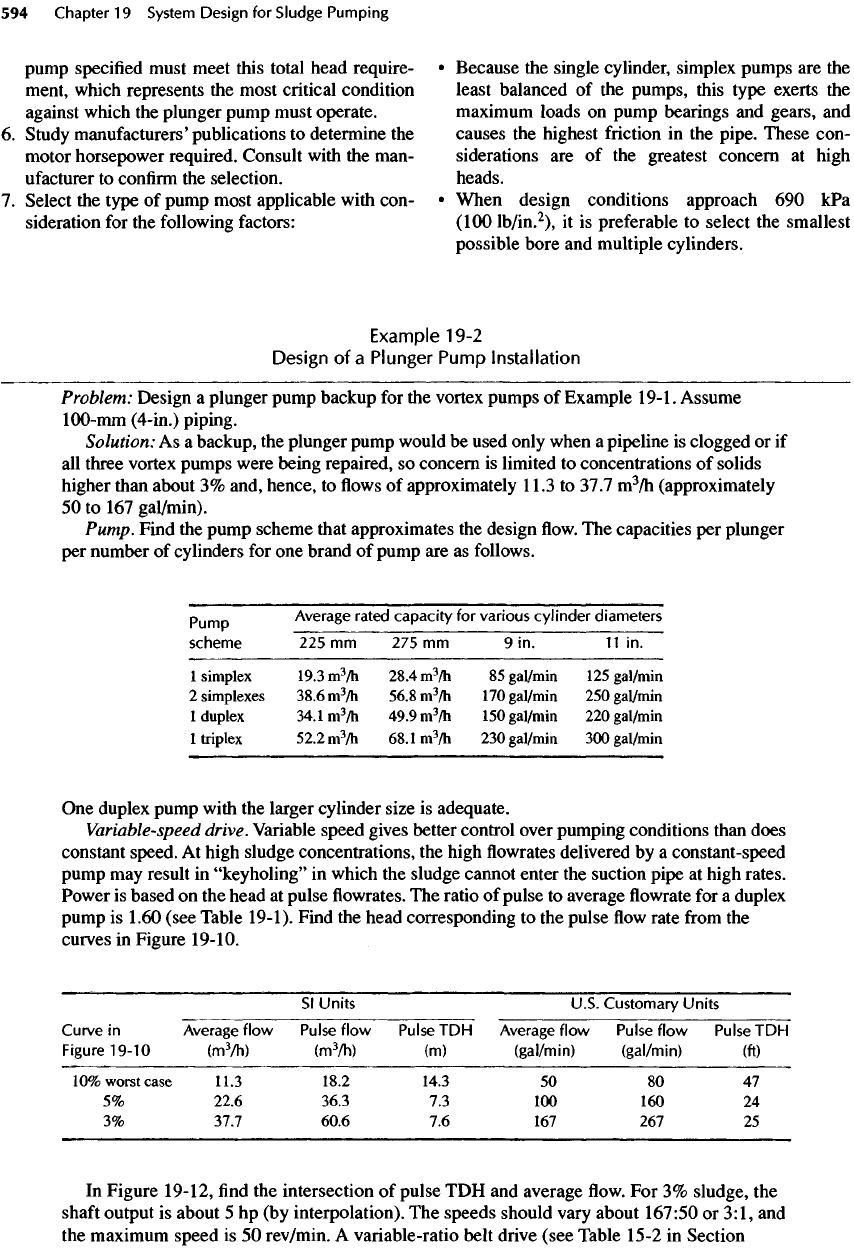
pump
specified must meet this total head require-
ment, which represents
the
most critical condition
against which
the
plunger pump
must
operate.
6.
Study
manufacturers'
publications
to
determine
the
motor horsepower required. Consult with
the
man-
ufacturer
to
confirm
the
selection.
7.
Select
the
type
of
pump most applicable with con-
sideration
for the
following factors:
•
Because
the
single cylinder, simplex pumps
are the
least balanced
of the
pumps, this type exerts
the
maximum
loads
on
pump bearings
and
gears,
and
causes
the
highest friction
in the
pipe. These con-
siderations
are of the
greatest concern
at
high
heads.
•
When design conditions approach
690 kPa
(100
lb/in.
2
),
it is
preferable
to
select
the
smallest
possible
bore
and
multiple
cylinders.
Example
19-2
Design
of a
Plunger Pump
Installation
Problem:
Design
a
plunger pump backup
for the
vortex pumps
of
Example
19-1.
Assume
100-mm
(4-in.)
piping.
Solution:
As a
backup,
the
plunger pump would
be
used only when
a
pipeline
is
clogged
or if
all
three vortex pumps were being repaired,
so
concern
is
limited
to
concentrations
of
solids
higher than about
3%
and, hence,
to flows of
approximately
11.3
to
37.7
m
3
/h
(approximately
50 to 167
gal/min).
Pump.
Find
the
pump scheme that approximates
the
design
flow. The
capacities
per
plunger
per
number
of
cylinders
for one
brand
of
pump
are as
follows.
Pump
Average
rated
capacity
for
various
cylinder
diameters
scheme
225 mm 275 mm 9 in. 11 in.
!simplex
19.3
m
3
/h
28.4
m
3
/h
85
gal/min
125
gal/min
2simplexes
38.6
m
3
/h
56.8
m
3
/h
170
gal/min
250
gal/min
!duplex
34.1
m
3
/h
49.9
m
3
/h
150
gal/min
220
gal/min
!triplex
52.2
m
3
/h
68.1
m
3
/h
230
gal/min
300
gal/min
One
duplex pump with
the
larger cylinder size
is
adequate.
Variable-speed
drive. Variable speed gives better control over pumping conditions than does
constant speed.
At
high sludge concentrations,
the
high
flowrates
delivered
by a
constant-speed
pump
may
result
in
"keyholing"
in
which
the
sludge cannot enter
the
suction pipe
at
high rates.
Power
is
based
on the
head
at
pulse
flowrates. The
ratio
of
pulse
to
average
flowrate for a
duplex
pump
is
1.60 (see Table
19-1).
Find
the
head corresponding
to the
pulse
flow
rate
from
the
curves
in
Figure
19-10.
Sl
Units
U.S.
Customary
Units
Curve
in
Average
flow
Pulse
flow
Pulse
TDH
Average
flow
Pulse
flow
Pulse
TDH
Figure
19-10
(m
3
/h)
(m
3
/h)
(m)
(gal/min)
(gal/min)
(ft)
10%
worst
case
11.3 18.2 14.3
50 80 47
5%
22.6 36.3
7.3 100 160 24
3%
37.7 60.6
7.6 167 267 25
In
Figure
19-12,
find the
intersection
of
pulse
TDH and
average
flow. For 3%
sludge,
the
shaft
output
is
about
5 hp (by
interpolation).
The
speeds should vary about
167:50
or
3:1,
and
the
maximum speed
is 50
rev/min.
A
variable-ratio belt drive (see Table 15-2
in
Section
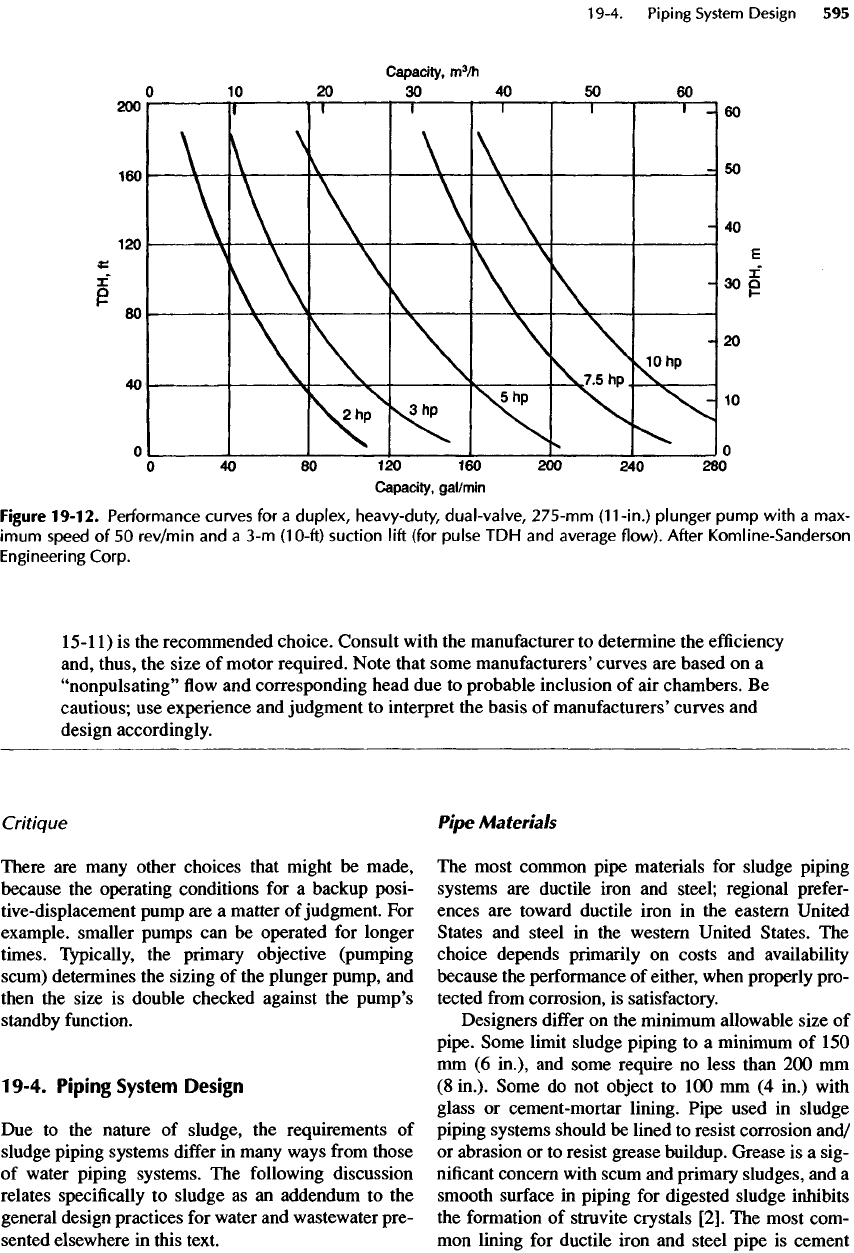
Critique
There
are
many other choices that might
be
made,
because
the
operating conditions
for a
backup posi-
tive-displacement pump
are a
matter
of
judgment.
For
example,
smaller pumps
can be
operated
for
longer
times. Typically,
the
primary objective (pumping
scum)
determines
the
sizing
of the
plunger pump,
and
then
the
size
is
double checked against
the
pump's
standby
function.
1
9-4.
Piping
System
Design
Due
to the
nature
of
sludge,
the
requirements
of
sludge piping systems
differ
in
many ways
from
those
of
water piping systems.
The
following discussion
relates specifically
to
sludge
as an
addendum
to the
general design practices
for
water
and
wastewater pre-
sented elsewhere
in
this text.
Pipe
Materials
The
most common pipe materials
for
sludge piping
systems
are
ductile iron
and
steel;
regional prefer-
ences
are
toward ductile iron
in the
eastern United
States
and
steel
in the
western United States.
The
choice depends primarily
on
costs
and
availability
because
the
performance
of
either, when properly pro-
tected
from
corrosion,
is
satisfactory.
Designers
differ
on the
minimum allowable size
of
pipe. Some limit sludge piping
to a
minimum
of
150
mm
(6
in.),
and
some require
no
less than
200 mm
(8
in.).
Some
do not
object
to 100 mm (4
in.) with
glass
or
cement-mortar lining. Pipe used
in
sludge
piping systems should
be
lined
to
resist
corrosion and/
or
abrasion
or to
resist grease buildup. Grease
is a
sig-
nificant
concern with scum
and
primary sludges,
and a
smooth
surface
in
piping
for
digested sludge inhibits
the
formation
of
struvite
crystals
[2].
The
most com-
mon
lining
for
ductile iron
and
steel
pipe
is
cement
Figure
19-12.
Performance
curves
for a
duplex,
heavy-duty,
dual-valve,
275-mm
(11-in.)
plunger
pump
with
a
max-
imum
speed
of 50
rev/min
and a 3-m
(10-ft)
suction
lift
(for
pulse
TDH and
average
flow).
After
Komline-Sanderson
Engineering
Corp.
15-11)
is the
recommended
choice.
Consult with
the
manufacturer
to
determine
the
efficiency
and,
thus,
the
size
of
motor required. Note that some
manufacturers'
curves
are
based
on a
"nonpulsating"
flow and
corresponding head
due to
probable inclusion
of air
chambers.
Be
cautious;
use
experience
and
judgment
to
interpret
the
basis
of
manufacturers' curves
and
design accordingly.
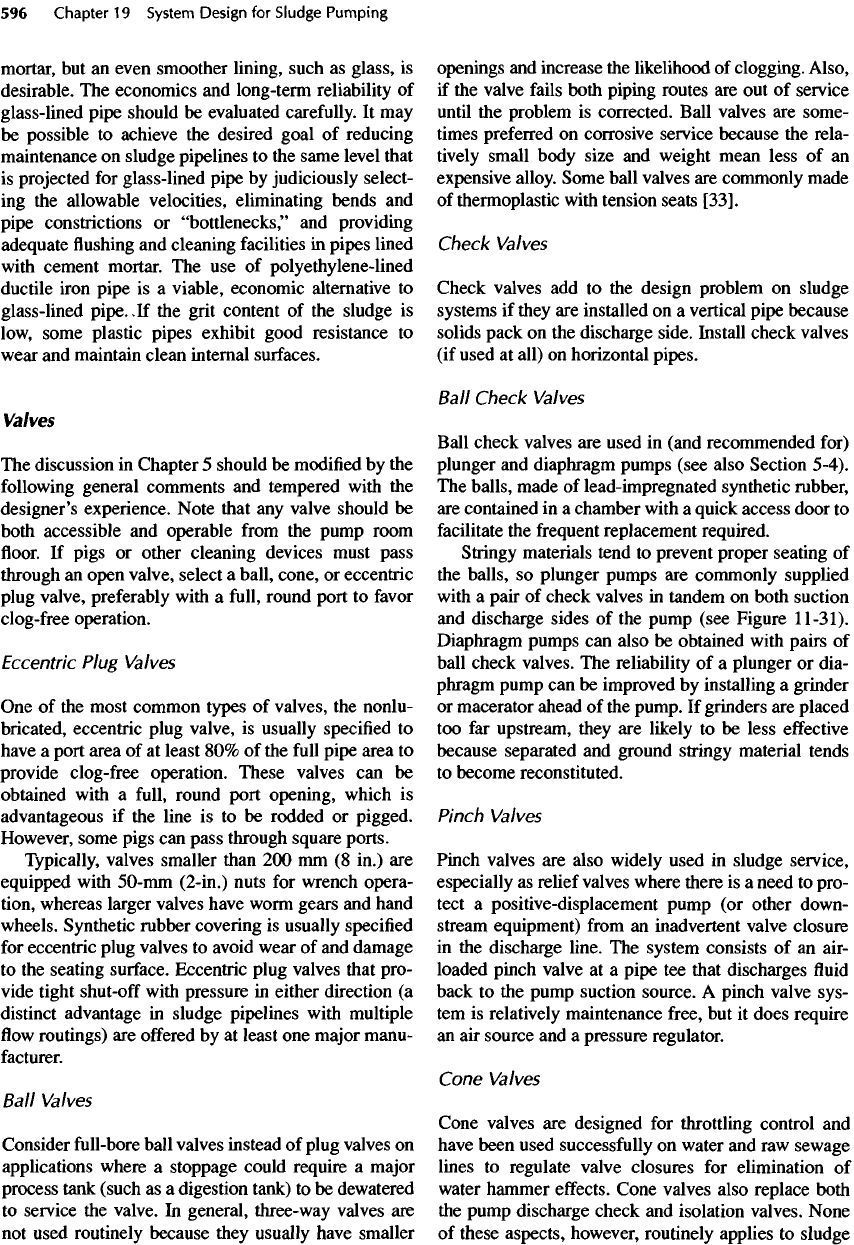
mortar,
but an
even smoother lining, such
as
glass,
is
desirable.
The
economics
and
long-term reliability
of
glass-lined pipe should
be
evaluated carefully.
It may
be
possible
to
achieve
the
desired goal
of
reducing
maintenance
on
sludge pipelines
to the
same level that
is
projected
for
glass-lined pipe
by
judiciously
select-
ing
the
allowable velocities, eliminating bends
and
pipe
constrictions
or
"bottlenecks,"
and
providing
adequate
flushing and
cleaning facilities
in
pipes
lined
with
cement mortar.
The use of
polyethylene-lined
ductile iron pipe
is a
viable, economic alternative
to
glass-lined pipe.
Jf the
grit content
of the
sludge
is
low,
some plastic
pipes
exhibit good
resistance
to
wear
and
maintain clean internal surfaces.
Valves
The
discussion
in
Chapter
5
should
be
modified
by the
following
general comments
and
tempered with
the
designer's experience. Note that
any
valve should
be
both accessible
and
operable
from
the
pump room
floor.
If
pigs
or
other cleaning devices must pass
through
an
open valve, select
a
ball, cone,
or
eccentric
plug
valve, preferably with
a
full,
round port
to
favor
clog-free
operation.
Eccentric
Plug
Valves
One of the
most common types
of
valves,
the
nonlu-
bricated,
eccentric plug valve,
is
usually specified
to
have
a
port area
of at
least
80% of the
full
pipe area
to
provide clog-free operation. These valves
can be
obtained with
a
full,
round port opening, which
is
advantageous
if the
line
is to be
rodded
or
pigged.
However, some pigs
can
pass through square
ports.
Typically,
valves smaller than
200 mm (8
in.)
are
equipped with
50-mm
(2-in.) nuts
for
wrench
opera-
tion, whereas larger valves have worm gears
and
hand
wheels. Synthetic rubber covering
is
usually specified
for
eccentric plug valves
to
avoid wear
of and
damage
to the
seating
surface.
Eccentric plug valves that pro-
vide tight
shut-off
with pressure
in
either direction
(a
distinct
advantage
in
sludge pipelines with multiple
flow
routings)
are
offered
by at
least
one
major
manu-
facturer.
Ball
Valves
Consider
full-bore
ball valves instead
of
plug valves
on
applications where
a
stoppage could require
a
major
process
tank (such
as a
digestion
tank)
to be
dewatered
to
service
the
valve.
In
general, three-way valves
are
not
used routinely because they usually have smaller
openings
and
increase
the
likelihood
of
clogging.
Also,
if
the
valve
fails
both piping routes
are out of
service
until
the
problem
is
corrected. Ball valves
are
some-
times preferred
on
corrosive service because
the
rela-
tively small body size
and
weight mean
less
of an
expensive alloy. Some ball valves
are
commonly made
of
thermoplastic with tension seats
[33].
Check
Valves
Check valves
add to the
design problem
on
sludge
systems
if
they
are
installed
on a
vertical pipe because
solids
pack
on the
discharge
side.
Install check valves
(if
used
at
all)
on
horizontal
pipes.
Ball
Check
Valves
Ball check valves
are
used
in
(and recommended for)
plunger
and
diaphragm pumps (see also Section 5-4).
The
balls, made
of
lead-impregnated synthetic rubber,
are
contained
in a
chamber
with
a
quick access door
to
facilitate
the
frequent
replacement required.
Stringy materials tend
to
prevent proper seating
of
the
balls,
so
plunger pumps
are
commonly supplied
with
a
pair
of
check valves
in
tandem
on
both suction
and
discharge sides
of the
pump (see Figure
11-31).
Diaphragm pumps
can
also
be
obtained with pairs
of
ball check valves.
The
reliability
of a
plunger
or
dia-
phragm pump
can be
improved
by
installing
a
grinder
or
macerator
ahead
of the
pump.
If
grinders
are
placed
too far
upstream, they
are
likely
to be
less
effective
because separated
and
ground stringy material tends
to
become reconstituted.
Pinch
Valves
Pinch valves
are
also widely used
in
sludge service,
especially
as
relief valves where there
is a
need
to
pro-
tect
a
positive-displacement pump
(or
other down-
stream equipment)
from
an
inadvertent valve closure
in
the
discharge
line.
The
system consists
of an
air-
loaded pinch valve
at a
pipe
tee
that discharges
fluid
back
to the
pump suction source.
A
pinch valve sys-
tem
is
relatively maintenance
free,
but it
does require
an
air
source
and a
pressure regulator.
Cone
Valves
Cone valves
are
designed
for
throttling control
and
have
been used successfully
on
water
and raw
sewage
lines
to
regulate valve closures
for
elimination
of
water hammer
effects.
Cone valves
also
replace
both
the
pump discharge check
and
isolation valves. None
of
these aspects, however, routinely applies
to
sludge
